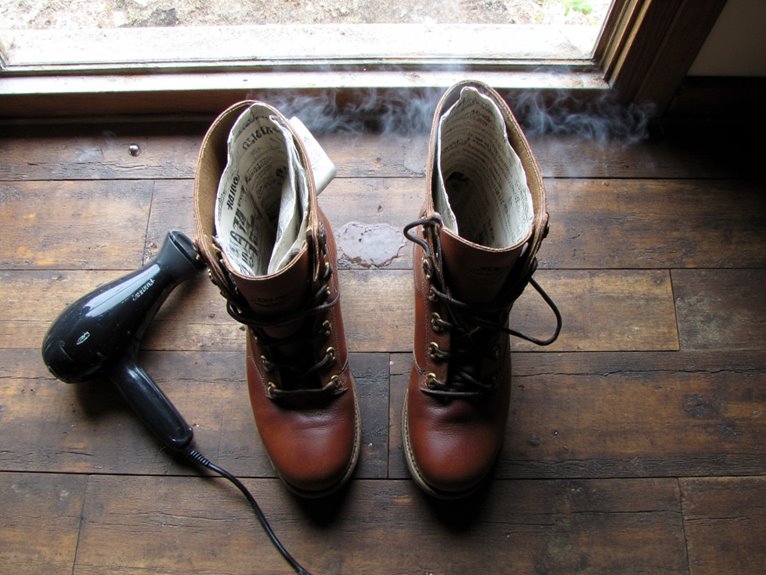How to Dry Wet Boots Without Damaging Them
Remove insoles and laces immediately to maximize airflow throughout your wet boots. Stuff crumpled newspaper into all corners, replacing every 2-3 hours for ideal moisture absorption. Never use direct heat sources like hairdryers or radiators, as temperatures above 80°F damage leather fibers and cause irreversible cracking. Position boots upside down with fan airflow directed inside, or use controlled boot dryers with proper temperature settings. Clean boots before drying to prevent permanent staining, then store in cool, dry locations with good ventilation to maintain their condition and discover advanced preservation techniques.
We are supported by our audience. When you purchase through links on our site, we may earn an affiliate commission, at no extra cost for you. Learn more. Last update on 5th January 2026 / Images from Amazon Product Advertising API.
Notable Insights
- Remove insoles and laces to maximize airflow and allow moisture to evaporate from all boot surfaces effectively.
- Stuff boots with newspaper or use silica gel packs, replacing absorbent materials every 2-3 hours for optimal moisture removal.
- Avoid direct heat sources like hairdryers or radiators as temperatures above 80°F can crack leather and damage materials.
- Clean mud and dirt before drying to prevent permanent staining and deeper contamination during the drying process.
- Store dried boots in cool, dry locations with good ventilation and apply leather conditioner to prevent cracking.
Remove Insoles and Laces for Maximum Airflow
When your boots are soaking wet, the first step you’ll want to take is removing both the insoles and laces completely. This creates considerable airflow advantages by eliminating the primary barriers to internal air circulation.
Insoles trap substantial moisture against the boot’s interior surface, acting like a wet sponge that prevents proper ventilation.
Removing laces allows the boot opening to expand fully, maximizing air entry points. This increased access enables moisture evaporation from all internal surfaces simultaneously rather than creating dead air pockets.
The unrestricted airflow reaches toe boxes, heel areas, and sidewall sections that would otherwise remain damp. For optimal results, replace microfiber towels used for stuffing every few hours as they become saturated with absorbed moisture.
Without these components, drying aids like fans or boot dryers operate at peak efficiency, circulating air through the entire boot cavity and accelerating the evaporation process considerably. Similar to how quick-dry technology in hiking gear can dry completely within one hour, proper airflow management significantly reduces boot drying time. Proper drying prevents blisters and infections that can develop when feet remain in contact with wet materials for extended periods.
Use Absorbent Materials to Draw Out Moisture
After maximizing airflow through your boots, you’ll need to actively pull moisture from the interior surfaces using absorbent materials.
Newspaper absorption works effectively when crumpled and pushed into all boot corners. Towel wrapping both externally and internally increases surface contact for faster drying.
Grain bags filled with rice or cat litter provide overnight moisture removal when placed inside boots. Silica gel packs offer specialized desiccant properties for storage situations.
Synthetic shammies excel at patting dry hard-to-reach areas under insoles and tongue folds.
Moisture replacement every 2-3 hours maintains absorbent efficiency as materials reach saturation frequency. Interior stuffing should allow some airspace to prevent restricting evaporation.
Combine these methods with airflow combination techniques using fans for optimal outcomes in dry, well-ventilated environments.
Avoid Direct Heat Sources That Can Damage Your Boots
You must never expose wet boots to direct heat sources like hairdryers, space heaters, or radiators, as temperatures above 80°F will cause leather fibers to contract and crack irreversibly.
Heat accelerates moisture evaporation too rapidly, removing essential oils that maintain flexibility and causing permanent shrinkage that alters boot fit.
Instead, choose safe drying alternatives like room-temperature air circulation or specialized boot dryers that operate at controlled low temperatures below 105°F with gentle airflow.
Heat Damages Boot Materials
Although drying wet boots quickly might seem like a priority, exposing them to direct heat sources can cause irreversible damage that’ll ruin your footwear.
Boot material deterioration occurs rapidly when temperatures exceed 140°F (60°C). Leather loses natural oils, becoming brittle and prone to cracking. Collagen fibers contract, causing permanent shrinkage that alters fit. Heat exposure risks extend beyond leather-synthetic materials trap heat internally, softening adhesives and weakening bonds between layers.
| Material Type | Damage Threshold | Primary Effects |
|---|---|---|
| Leather | 140°F (60°C) | Oil loss, brittleness, cracking |
| Neoprene | 120°F (49°C) | Fiber breakdown, accelerated aging |
| Synthetic fabrics | 100°F (38°C) | Adhesive failure, delamination |
| Rubber soles | 160°F (71°C) | Warping, reduced flexibility |
Heat damage particularly affects high-quality waterproof technology found in premium hiking boots, compromising the protective membranes that keep feet dry during outdoor activities.
Avoid radiators, hair dryers, and direct sunlight for drying.
Safe Drying Alternatives
When excessive heat threatens your boots’ integrity, several proven methods can safely remove moisture without causing material damage.
Alternative drying methods protect leather, rubber, and synthetic materials from warping or cracking. These moisture retention techniques work by controlling airflow and absorption rates.
Effective safe drying options include:
- Newspaper stuffing – Replace crumpled paper every 2-3 hours for ideal moisture absorption
- Boot dryers – Provide controlled airflow with temperature limits and automatic timers
- Air circulation – Position boots upside down with fans directing airflow into openings
- Natural sunlight – Use warm, dry conditions while rotating boots hourly for even drying
- Microfiber towels – Absorb moisture faster than traditional newspaper stuffing
Remove insoles and laces before applying any method.
These techniques preserve boot structure while eliminating trapped moisture effectively.
Proper Boot Dryer Use
Boot dryers offer the most controlled method for removing moisture while protecting your footwear from heat damage. Place your unit on a firm, flat surface away from secondary heat sources like fireplaces or floor vents. These additional heat sources can cause overheating and material degradation.
Proper assembly guarantees peak boot dryer efficiency. Align base plates and secure drying tubes tightly for consistent warm air circulation. Position boots upside down with toes elevated above heels. Maintain 6-8 inches clearance between boot tops and the dryer base for adequate airflow management.
Use manufacturer-recommended heat settings and monitor drying times closely. Loosen laces and tongues before placement to maximize internal air circulation.
Never block air vents completely, as restricted airflow reduces efficiency and can damage both boots and equipment.
Choose the Right Boot Dryer and Airflow Methods
Since wet boots can damage floors and create uncomfortable conditions for your next outing, selecting an appropriate boot dryer becomes essential for proper footwear maintenance.
Modern drying technologies offer distinct advantages for different scenarios. Forced air dryers circulate warm air through specialized tubes, reaching inner linings effectively. PTC ceramic heating elements provide self-regulating temperature control while reducing energy consumption.
Key dryer features to evaluate include:
- Adjustable airflow and heat settings for material-specific drying
- Multiple drying tubes accommodating various boot sizes and styles
- Built-in timers (1-3 hours) preventing over-drying and material damage
- UV sterilization capabilities eliminating bacteria and odors
- Quiet operation for household convenience
Thermal convection creates warm air circulation throughout boot interiors, while air-only modes protect delicate materials from heat damage. Avoid high-heat settings when drying boots to preserve their insulation properties and prevent material deterioration. When considering protective gear for outdoor activities where boots may get wet, prioritize jackets with sealed seams that effectively block moisture penetration and maintain warmth in challenging conditions.
Choose Appropriate Cleaners
Once you’ve removed all visible dirt and debris, selecting the right cleaning solution becomes your next priority for proper boot maintenance. Appropriate cleaning methods depend entirely on your boot’s material composition.
Use neutral cleaners like mild dish soap mixed with lukewarm water for general cleaning without material damage. Leather boots require saddle soap and water to preserve essential oils, while suede needs talcum powder for moisture absorption instead of wet cleaning. Rubber boots respond well to detergent mixed with warm water for salt stain removal.
Consider biodegradable options like Nikwax Footwear Cleaning Gel for hiking boots or vinegar-water solutions as natural disinfectants. Avoid harsh detergents or bleach entirely.
Specialized footwear cleaning gels offer targeted solutions for specific materials, ensuring the best cleaning without compromising structural integrity.
Prevent Mold, Mildew, and Long-Term Material Damage
Because wet boots create ideal conditions for mold and mildew growth, you’ll need to act quickly to prevent permanent damage to your footwear. Effective mold prevention starts with thorough cleaning using diluted vinegar solution before drying. Remove insoles and laces separately to eliminate moisture pockets where spores thrive.
| Mildew Control Method | Implementation Timeline |
|---|---|
| Clean with vinegar solution | Before drying process |
| Replace absorbent materials | Every 2-3 hours |
| Apply leather conditioner | After complete drying |
| Insert silica gel packets | During drying/storage |
Position fans directly into boot openings to enhance airflow. Stuff boots with dry newspaper, replacing every 2-3 hours. Never use direct heat sources like radiators, which crack leather and warp adhesives. Store in well-ventilated areas with dehumidifiers in high-humidity environments.
Frequently Asked Questions
How Long Does It Typically Take to Dry Wet Boots Completely?
Drying time depends on your chosen drying techniques and boot wetness. You’ll need 1-3 hours with fan-forced dryers, while convection methods take 6-12 hours for completely wet boots.
What Should I Do if My Boots Smell After Drying Them?
Try natural deodorants like baking soda sprinkled overnight or white vinegar spray for smell removal. You can also use activated charcoal insoles, antifungal foot powders, or antibacterial sprays designed for footwear.
On a final note
You’ve now got the essential techniques to dry your boots safely and effectively. Remember to remove insoles and laces first, use absorbent materials like newspaper or cedar shavings, and avoid direct heat sources above 100°F. Choose proper airflow methods or specialized boot dryers with temperature controls. Clean boots before drying, monitor for mold prevention, and store them in ventilated areas. These methods’ll preserve your boots’ materials and extend their lifespan considerably.

